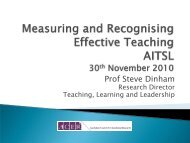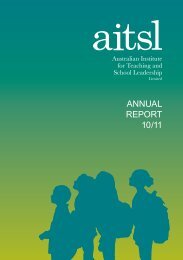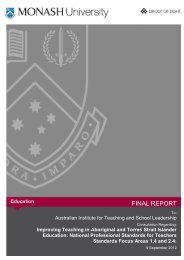impersonal relationships• rational models emphasising processes of problem-solving and decision-making• formal managerial models where the focus is on the competent performance of functions and taskssuch as supervision, staffing, testing, community responsiveness etc.• collegial models and participative leadership, where power and decision-making are shared• transformational models, where the central focus is the commitment and capacities oforganisational members• interpersonal leadership, with an emphasis on supportive teamwork, reminiscent of authenticleadership as described by Avolio, Walumba and Weber (2009). (See above page 22.)Transformational leadership, usually in combination with collegial and interpersonal models, is seen asa key to successful individual leadership. Davies (2010, p. 11), who uses the term strategic leadership,describes the role as ‘creating a vision and setting the direction of the school over the medium tolonger term’ and creating ‘strategic conversations to build viable and exciting pathways to create thecapacity to achieve that future’. While the reference here is to principals, the characteristics of strategicleaders which Davies identifies are more generally relevant. Strategic leaders are strategic thinkers andlearners, as well as talent developers who balance the strategic and the operational, deploy strategicplanning and action, and define measures of success.The literature on school leadership has until the last decade or so been overwhelmingly dominated bya concern for principal leadership, and this remains the key focus of the literature. However, since therise of collegial, transformational and interpersonal models of leadership, increasing attention has beengiven to the relations between principal and staff, and in particular the increased engagement of staffin decision-making (Goddard and Miller 2010). The result has been a strong shift to considerations ofcollaborative leadership as an approach to school improvement and change, and the introduction of thecorresponding concept of distributed leadership (Hallinger 2007; Hallinger and Heck 2010; Kochan andReed 2005; Louis et al. 2010).Research provides clear evidence that collaborative leadership can positively affect student learningthrough building the school’s capacity for academic improvement (Hallinger and Heck 2010; Harris,Leithwood, Day, Sammons and Hopkins 2007). In a study of 192 US elementary schools over afour-year period, Hallinger and Heck, (2010, p. 654) found ‘significant direct effects of collaborativeleadership on change in the schools’ academic capacity and indirect effects on rates of growth instudent reading achievement’.Leithwood and Mascall (2008) studied the impact of collective, or shared, leadership on key teachervariables and student achievement through an analysis of 2570 teacher responses from 90 Englishelementary and secondary schools. They concluded that collective leadership explained a significantproportion of variation in student achievement across schools, as higher-achieving schools awardedleadership influence to all school members and other stakeholders to a greater degree than lowerachievingschools. These differences were most significant in relation to the leadership exercised byschool teams, parents, and students.However, the means by which leadership achieves its effects are complex. Noting that leadership andcapacity-building are mutual influences on each other, rather than either acting in isolation, Hallinger andHeck (2010, p. 106) observe:The research implies that while leadership acts as a catalyst for school improvement, both thenature of leadership as well as its impact are shaped by both historical and current conditionsin the school. Academic structures (e.g., curriculum standards, team-based collaboration),school norms (e.g., tangible support for students and teachers, professional learning, opencommunication), and ongoing organizational processes (e.g., opportunities for participation indecision-making, resource allocation, external policies) create both opportunities and constraintsfor leadership (Bridges, 1977). Effective leadership for school improvement must be responsive to19 <strong>Professional</strong> <strong>Learning</strong> <strong>Flagship</strong> <strong>Program</strong>: <strong>Leading</strong> <strong>Curriculum</strong> <strong>Change</strong>: Literature Review
these contextual characteristics. Our findings indicated that at each point in time, the impact of theschool’s culture on leadership was greater than vice versa.Continuing this research into the mediators of leadership, Leithwood, Pattern, and Jantzi (2010) studiedthe relationship between leadership and four ‘paths’ along which leadership influence might flow. Thepaths were represented by variables as follows: the rational path by academic standards and classroomdiscipline; the emotions path by collective teacher efficacy and trust of colleagues; the organisationalpath by efficient organisation of time and involvement in professional learning communities; and thefamily path by home support for homework and family computer ownership. The results showed similarlysized, significant, and positive contributions by the rational, emotions and family paths, but no significanteffects for the organisational path. The key issue here seems to be that principal leadership has nodirect effects in itself, but only as it affects and is mediated by other aspects of the school’s operation.On the other hand, the importance of the emotions path, where collective teacher efficacy was the mostinfluential element, further endorses the importance of collaboration.By virtue of its potential for engaging a range of staff in initiating the change process, collaborativeleadership is the most relevant approach for developing curriculum leadership throughout a school, andconsequently warrants close consideration as a model for developing leaders of curriculum change. Itsmost well-developed form in recent times is distributed leadership.Distributed leadershipA commonly cited definition of distributed leadership (DL) is that of Copland (2003, p. 376), who seesDL as:... a set of functions or qualities shared across a much broader segment of the school communitythat encompasses administrators, teachers and other professionals and community members bothinternal and external to the school. Such an approach imposes the need for school communities tocreate and sustain broadly distributed leadership systems, processes and capacities.In their review of the literature on DL, Bennett, Wise, and Woods (2003) identify three distinctiveelements of the concept:• DL is an emergent property of a group or network of interacting individuals in which the outcome isgreater than the sum of the parts.• DL suggests openness of the boundaries of leadership so that any or all members can play someleadership role.• DL recognises that expertise and valuable ideas and capabilities can be found in individuals spreadthroughout the organisation. DL picks up on a range of developments in leadership and schoolchange. It links closely to the importance of teamwork, collaboration, collective responsibility andflexible application of expertise.In her study of DL in schools, Harris (2008) identified common principles underlying DL in practice. DLwas a broad-based leadership activity, with multiple levels of involvement in decision-making focusingprimarily on classroom practice. It encompassed both formal and informal leaders, linking vertical andhorizontal leadership structures, and extending to students and the encouragement of student voice. Itsflexibility meant that groups were not permanent, but fluid and interchangeable. The cases gave rise toeight characteristics of distributed leadership:• Vision is a unifying force when clearly articulated and shared.• Leaders have expert rather than formal authority, which shifts according to need and task.• Collaborative teams are formed for specific purposes, with fluid membership.• Communities of practice emerge and maintain their affiliation long after the collaborative activitiesof the task are completed, often to brainstorm future needs and further possible collaborations.• Individuals perceive themselves as stakeholders, and are willing and able to assume leadershippositions when needed.<strong>Professional</strong> <strong>Learning</strong> <strong>Flagship</strong> <strong>Program</strong>: <strong>Leading</strong> <strong>Curriculum</strong> <strong>Change</strong>: Literature Review 20
- Page 1 and 2: Professional Learning FlagshipProgr
- Page 3 and 4: ContentsIntroduction ..............
- Page 5 and 6: Curriculum change: Implications for
- Page 7 and 8: Table 1: Overview of factors affect
- Page 9 and 10: This emphasis on capacity-building
- Page 11 and 12: Much of the foregoing discussion is
- Page 13 and 14: Features of successful professional
- Page 16 and 17: p. 1051) conclude that, ‘Findings
- Page 18 and 19: 2007; Gruenert 2005; Printy 2008; S
- Page 20 and 21: RecommendationsProfessional learnin
- Page 24 and 25: • The organisational goals are di
- Page 26 and 27: Table 2: Two views of teacher leade
- Page 28 and 29: A range of specifications and stand
- Page 30 and 31: In secondary schools, teacher leade
- Page 32 and 33: 1. Stimulus for innovation — Why
- Page 34 and 35: Table 4: Elements and processes of
- Page 36 and 37: The education of Indigenous student
- Page 38 and 39: ReferencesAinscow, M. (2005). Devel
- Page 40 and 41: Daly, A. J. (2009). Rigid Response
- Page 42 and 43: Hall, R. (1997). Knowledge Use and
- Page 44 and 45: Meirink, J., Meijer, P., Verloop, N
- Page 46 and 47: Thorpe, R., and Gold, J. (2010). Le
- Page 48: aitsl.edu.auFurther informationTele
















